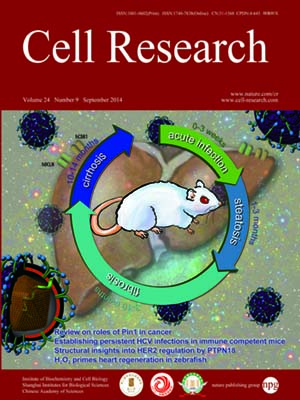
Volume 24, No 9, Sep 2014
ISSN: 1001-0602
EISSN: 1748-7838 2018
impact factor 17.848*
(Clarivate Analytics, 2019)
Volume 24 Issue 9, September 2014: 1067-1090 | Open Access
ORIGINAL ARTICLES
The catalytic region and PEST domain of PTPN18 distinctly regulate the HER2 phosphorylation and ubiquitination barcodes
Hong-Mei Wang1,2,*, Yun-Fei Xu1,2,*, Shang-Lei Ning3,*, Du-Xiao Yang1, Yi Li4, Yu-Jie Du2, Fan Yang2, Ya Zhang2, Nan Liang1,4, Wei Yao2, Ling-Li Zhang1, Li-Chuan Gu5, Cheng-Jiang Gao1, Qi Pang4, Yu-Xin Chen3, Kun-Hong Xiao6, Rong Ma3, Xiao Yu1,2,3 and Jin-Peng Sun1,4
1Key Laboratory for Experimental Teratology of the Ministry of Education and Department of Biochemistry and Molecular Biology, Shandong University School of Medicine, Jinan, Shandong 250012, China
2Department of Physiology, Shandong University School of Medicine, Jinan, Shandong 250012, China
3Qilu Hospital, Shandong University, Jinan, Shandong 250012, China
4Shandong Provincial Hospital, Shandong University, Jinan, Shandong 250021, China
5Shandong University, School of Life Science, Jinan, Shandong 250012, China
6Duke University, School of Medicine, Durham, 27705, USA
Correspondence: Xiao Yu, E-mail: yuxiao@sdu.edu.cn; Jin-Peng Sun, E-mail:(sunjinpeng@sdu.edu.cn)
The tyrosine phosphorylation barcode encoded in C-terminus of HER2 and its ubiquitination regulate diverse HER2 functions. PTPN18 was reported as a HER2 phosphatase; however, the exact mechanism by which it defines HER2 signaling is not fully understood. Here, we demonstrate that PTPN18 regulates HER2-mediated cellular functions through defining both its phosphorylation and ubiquitination barcodes. Enzymologic characterization and three crystal structures of PTPN18 in complex with HER2 phospho-peptides revealed the molecular basis for the recognition between PTPN18 and specific HER2 phosphorylation sites, which assumes two distinct conformations. Unique structural properties of PTPN18 contribute to the regulation of sub-cellular phosphorylation networks downstream of HER2, which are required for inhibition of HER2-mediated cell growth and migration. Whereas the catalytic domain of PTPN18 blocks lysosomal routing and delays the degradation of HER2 by dephosphorylation of HER2 on pY1112, the PEST domain of PTPN18 promotes K48-linked HER2 ubiquitination and its rapid destruction via the proteasome pathway and an HER2 negative feedback loop. In agreement with the negative regulatory role of PTPN18 in HER2 signaling, the HER2/PTPN18 ratio was correlated with breast cancer stage. Taken together, our study presents a structural basis for selective HER2 dephosphorylation, a previously uncharacterized mechanism for HER2 degradation and a novel function for the PTPN18 PEST domain. The new regulatory role of the PEST domain in the ubiquitination pathway will broaden our understanding of the functions of other important PEST domain-containing phosphatases, such as LYP and PTPN12.
10.1038/cr.2014.99
FULL TEXT | PDF
Browse 2473


